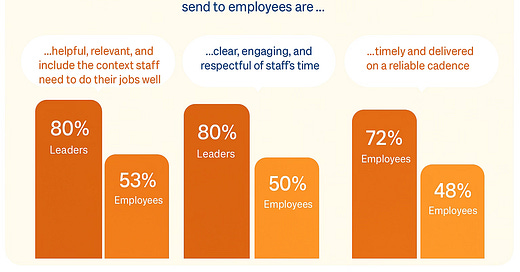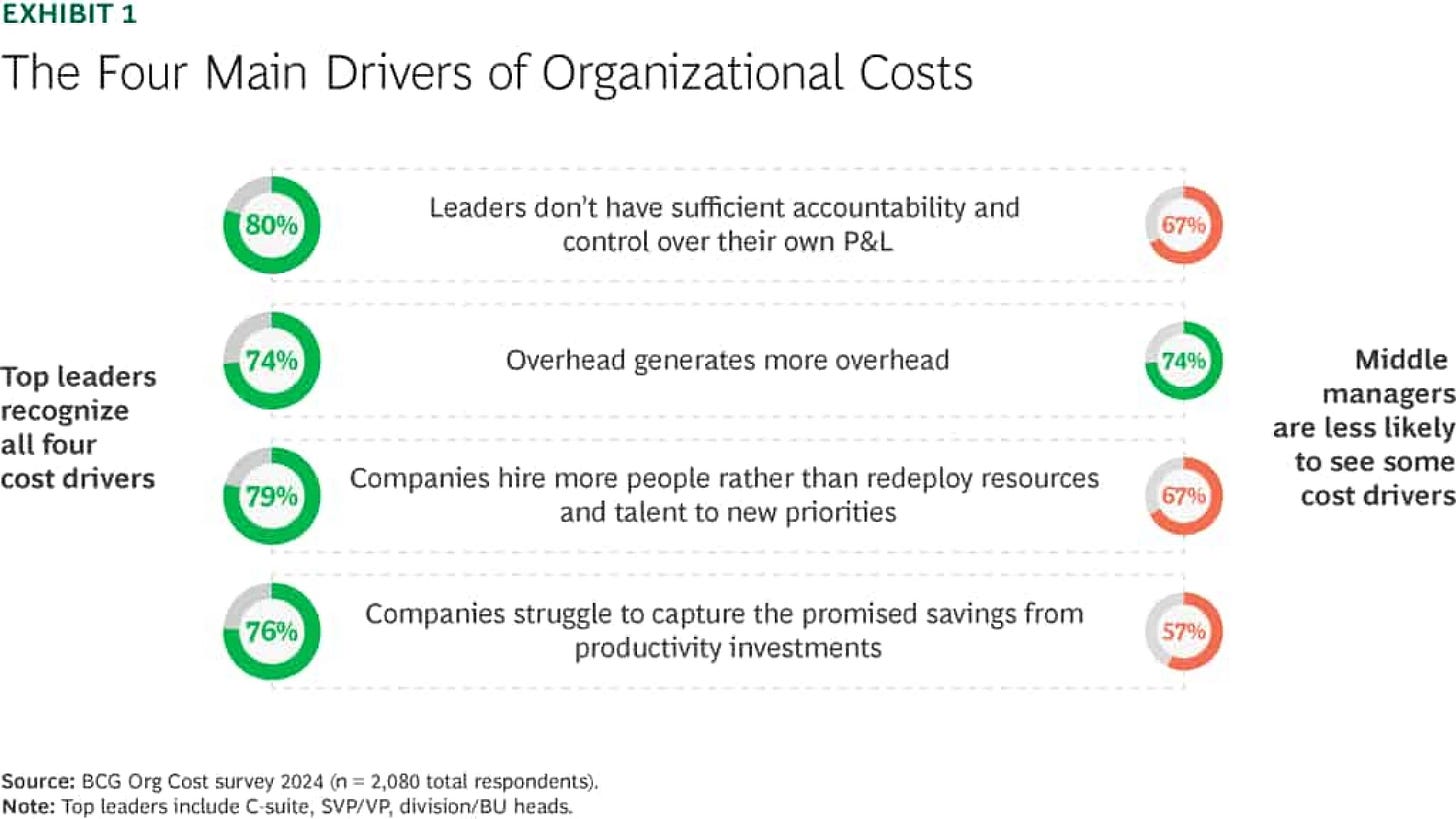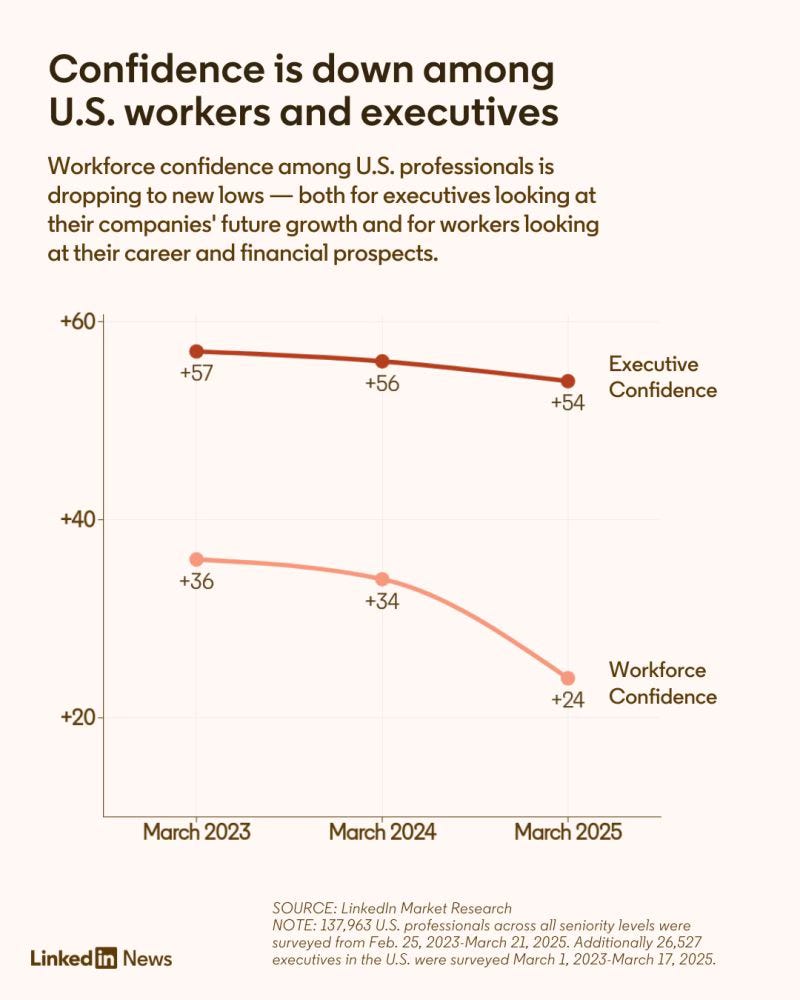Human Capital Intel - 4/22/25
Back to leadership basics | No more 'quiet' trends! | L&D meets P&L | 4 organizational cost challenges | Too many degrees, too few skills
Welcome to the latest edition of Human Capital Intelligence, your weekly brief synthesizing over 250 leadership, HR, and people sources to filter out the noise. As always, we would love to hear from you at ken@reyvism.com with questions you’d like answered or topics covered.
Sent this by a friend? Sign up here to receive HCI in your inbox every week.
By Ken Stibler; Powered by Reyvism Analytics
New management competences are built on leadership basics
Hybrid leadership is hard, and a changing economy and marketplace require new skills from tariff management to AI adoption. Yet, a lack of clear communication can still sabotage organizations, regardless the leaders’ next-gen skills.
Leaders consistently overestimate their fundamentals. While nearly 80% executives believe their messaging resonates, data reveals only 9% of employees feel truly aligned with company goals, underscoring that effective communication—not technology—forms the bedrock of successful management.
The direct correlation between communication quality and employee engagement proves that regardless of AI advancements, leadership competence still hinges on transparency and clarity. As organizations navigate AI integration and rapid workplace change, the most successful leaders build new technical competencies upon timeless fundamentals: clear vision-sharing, active listening, and information prioritization that helps workers perform effectively.
Rather than replacing established leadership principles, tomorrow's management competencies enhance them with technological capabilities—creating frameworks that balance innovation with human-centered approaches to drive sustainable organizational performance in an increasingly AI-driven business environment.
What’s Next: The mental model HCI uses is to identify and invest in what is necessary, whether it is old, and dismiss the rest as noise.
Saying the ‘quiet’ part out loud on employee engagement
Someone has to say it: stop rebranding disengagement each quarter! The corporate world's obsession with "quiet" workplace trends—this month's “quiet cracking”—is rebranding and trivializing fundamental breakdowns in trust, communication, and engagement.
(Don’t) Read more:
What is ‘quiet cracking’?
Quiet quitting is about a sense of self
Quiet vacationing: What’s this summer work trend?
What is ‘quiet hiring’?
I’m sure there are other variants, they’re just a bit too quiet to find…
You already know the stats, we cover them regularly. But rather than confronting these persistent leadership failures directly, many organizations chase engagement software and buzzword-driven initiatives that measure symptoms instead of addressing causes.
What’s Next: There’s no easy solution for authentic communication, meaningful growth opportunities, and genuine leadership involvement—basic principles that predate consultant-crafted terminology, and will outlast whatever "quiet" phenomenon emerges next quarter.
Quote: Waiting on universities to catch up
“The active use of AI for better outcomes is what companies are after. I think it would be quite beneficial for educational institutions to teach that before you get to the company.”
—Dara Khosrowshahi, CEO of Uber, noting that not enough of his employees are educated on how to use AI at the company
Reading List:
Solving the top organizational cost challenges
Despite regularly implementing cost-cutting initiatives, three-quarters of companies fail to achieve sustainable results according to BCG research. Rather than addressing surface-level symptoms, successful organizations tackle four fundamental behavioral drivers that cause costs to return: insufficient P&L accountability among leaders, proliferation of overhead and bureaucracy, failure to redeploy resources to new priorities instead of adding headcount, and inability to capture promised savings from productivity investments.
What’s Next: Download the BCG PDF, upload it to ChatGPT, and prompt it for ways to target each cost center for your business (providing context about your businesses’ unique elements where possible).
Too many degrees, too few skills
The American job market faces a critical misalignment between academic credentials and practical workforce needs, as graduates increasingly pursue advanced degrees despite diminishing returns. With graduate school applications surging amid a "low hiring, low firing" environment where unemployment for young adults has risen two percentage points since 2023, many are gambling on additional credentials and substantial debt to overcome entry barriers in a competitive market where bachelor's degrees have become devalued.
What’s Next: With non-traditional pathways like apprenticeships, training programs, and certificates gaining momentum, tapping into the non-degree job market can be a short cut to higher quality early-career talent.
How to attribute P&L to L&D
The combo of reskilling efforts and recession-prep cost cutting make it more important to demonstrated learning and development - a first cut during downturns - is a strategic and measurable investment. Rebranding from a cost center to a long–term profit driver requires businesses to track correlations between specific training programs and performance metrics across all employee levels, comparing training costs against productivity improvements and retention rates.
What’s Next: L&D is critical for engagement, future readiness, and improved quality. HR leaders justifying these investments is easier than ever with the help of AI to translate training’s impact to finance.
Data Point:
In Other News:
More than 60% of CEOs predict a recession or slowdown in the coming months: ‘This uncertainty needs to stop. (Fortune)
The most important skill for leaders? Delegation. (HR Dive)
Compliance is the New American Dream - how risk aversion has shaped our schools, our government, and our global standing. (Kayla Scanlon)
Complying With the ADA When Managing Employees With Alcoholism. (Ogletree Deakins)
Women are still softening their workplace communications — and it’s hurting their productivity and career prospects. (WorkLife)
Why AI Might Not Take All Our Jobs—if We Act Quickly. (Wall Street Journal)
‘An Overwhelmingly Negative And Demoralizing Force’: What It’s Like Working For A Company That’s Forcing AI On Its Developers. (Aftermath)
LinkedIn report: Your employees need better AI skills to get your company ahead. (WorkLife)






